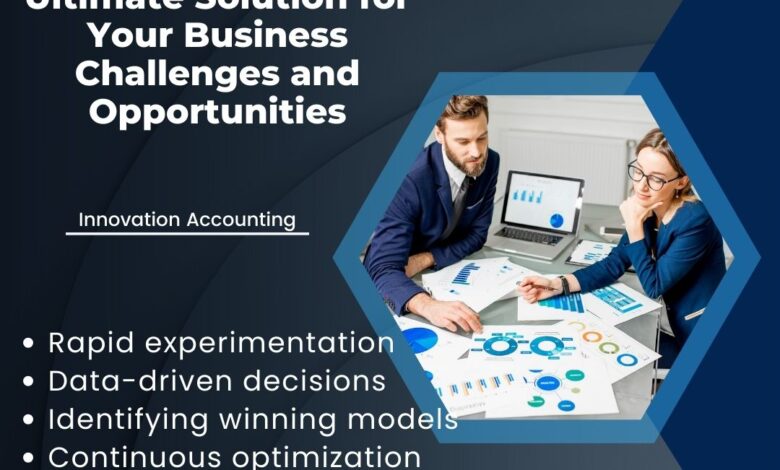Innovation Accounting: The Ultimate Solution for Your Business Challenges and Opportunities

In today’s competitive business landscape, companies must innovate constantly to stay ahead. But how do you know if your innovation efforts are paying off? That’s where innovation accounting comes in. It is a framework for measuring and evaluating innovation initiatives. It involves setting goals, defining metrics, tracking progress, and determining ROI.
With innovation accounting, companies can make smarter decisions to drive growth. In this post, we’ll cover what innovation accounting entails, how to implement it, and real-world examples of it in action. Let’s dive in.
Why Innovation Accounting Matters in Today’s Competitive Landscape
With today’s rapid pace of change, innovation is essential for companies to gain a competitive advantage. However, innovation initiatives often fail at a high rate. The following charts by Forbes, show the failure rate of innovation initiatives.
46% of resources allocated to innovation are wasted due to poor execution and lack of accountability. Companies can end up throwing time, money, and effort at new ideas without seeing real results.
This waste and lack of return on innovation investment can be attributed to several factors:
- No systemic way to measure and track progress in innovation efforts
- Lack of processes to quickly test ideas before scaling them
- Tendency to persist on failing innovations due to personal biases
- Inability to accurately compare the performance of different initiatives
- Rewarding outputs like the number of new products vs. real business outcomes
This is where innovation accounting comes in. Providing consistent data, measurement, and transparency in innovation efforts, enables organizations to overcome these challenges:
- Rapid experimentation: Quickly validate new ideas through MVP testing before making major investments. Fail fast and cheap.
- Data-driven decisions: Objectively evaluate progress towards goals and make better resource allocation decisions based on metrics.
- Identifying winning models: Analyze performance differences between initiatives to identify winning strategies to scale up.
- Continuous optimization: Optimize innovation processes over time based on hard data rather than hunches or guesswork.
- Accountability: Increase accountability across teams to drive disciplined execution excellence on innovation efforts.
Without the rigor of innovation accounting, companies are essentially “flying blind” in their innovation efforts. In today’s data-driven business environment, that can be a recipe for wasted time, resources, and missed opportunities.
By implementing innovation accounting, companies can accelerate innovation, maximize ROI, and gain competitive advantage. The data-driven insights uncover what’s working, what’s not, and where to place bets for the future.
How to Implement Innovation Accounting in Your Business
Implementing an innovation accounting framework takes careful planning and execution across teams, systems, and processes. Here are the best practices to drive adoption:
1. Define Innovation Goals and KPIs
Get leadership alignment on 1-2 top innovation objectives tied to company growth goals. For example, increase mobile app revenue by 20% in 1 year. Define quantitative KPIs to track progress for each goal. Metrics could include new users, usage metrics, conversion rates, revenue, etc.
Ensure the metrics are leading indicators that allow time to course correct. Lagging metrics like profit may come too late.
2. Develop Minimum Viable Products (MVPs)
Break large, complex initiatives into smaller MVPs that can be tested quickly. MVPs validate assumptions and give you data to guide the next steps vs. overinvesting upfront in the wrong direction.
For example, test demand for a feature with a simple landing page rather than building out the full feature.
3. Track Actionable Metrics
Identify and track metrics that directly influence performance for each initiative. Vanity metrics like social media likes don’t necessarily drive outcomes. Focus on actionable metrics tied to goals.
For an email campaign, track opens and clicks, but also drill down into sales influenced by the campaign.
4. Use Agile Development Cycles
Work in rapid cycles of building, measuring, and learning – sprints of 1-2 weeks work best. Update plans and priorities dynamically based on the data and insights uncovered.
Automate metric collection where possible using analytics tools to enable rapid analysis.
5. Make Pivot or Persevere Decisions
Review metrics frequently and make objective data-driven decisions on whether to pivot or persevere. Beware of biases that cause teams to persist in failing efforts. Sever quickly and redeploy resources to high-potential areas.
Celebrate disciplined pivots as smart risk management vs. seeing them as failures.
Addressing Potential Challenges
To overcome common hurdles:
- Invest in measurement skills and capacities like analytics, data visualization, and experimentation.
- Make data and insights transparent across the organization to drive accountability.
- Start small and demonstrate wins to gain buy-in.
With the right foundation in place, innovation accounting unlocks data-driven growth and innovation.
Case Studies: Innovation Accounting in Action
Here are two examples of companies using innovation accounting principles and practices to drive growth:
HubSpot
HubSpot is an inbound marketing and sales platform. By leveraging innovation accounting, HubSpot has optimized its product development processes.
- Challenge: Needed to speed up product iteration and decision-making for growth.
- Solution: Created an innovation accounting framework and team to support it.
- Results: Decreased time between experiments from 6 months to 6 weeks. Grew annual recurring revenue from $1M to over $100M in 6 years.
According to HubSpot CEO Brian Halligan, Innovation accounting has been instrumental to growing our business.
Netflix
Netflix is a leading entertainment streaming platform. Innovation accounting has enabled Netflix to deliver award-winning original content and personalization.
- Challenge: Needed to transition from DVD rentals to streaming without losing customers.
- Solution: Used A/B testing and experimentation to guide decision-making on features and content.
- Results: Grew from 1 million streaming subscribers in 2007 to over 200 million subscribers today. The average viewer enjoys Netflix for about 2 hours a day!
As Netflix CEO Reed Hastings said, “We have to be pioneering and move quickly. We decided to track progress with simple metrics.”
Final Thoughts
In today’s fast-changing business environment, rapid experimentation and data-driven decisions are key to effective innovation. Innovation accounting provides a proven framework for companies to set clear innovation goals, track progress with actionable metrics, and guide smart resource allocation.
The bottom line is that a disciplined, metrics-driven approach to innovation through accounting principles helps companies accelerate innovation, maximize ROI, and capitalize on new opportunities. Start small by defining key innovation KPIs, testing MVPs, tracking actionable metrics, and using agile development cycles.
Let data guide your decisions to pivot or persevere. With the right innovation accounting framework, you can overcome innovation challenges and achieve real results like HubSpot and Netflix. What are your thoughts on implementing innovation accounting? What questions do you have? Let us know in the comments!
FAQs
- What are some common innovation KPIs to track?
Some common innovation KPIs include:
- Number of new ideas generated
- Experiments or MVPs completed
- Customer adoption or usage rates of new products
- Revenue or profit from innovation initiatives
- Time to complete experiments/MVPs
- Employee engagement/morale
- How is innovation accounting different from traditional accounting?
Traditional accounting focuses on financial metrics like revenues, costs, and profitability. Innovation accounting expands measurement to also track progress and results of innovation initiatives, like new ideas, experiments, product usage, etc.
- What skills does my team need to implement innovation accounting?
Important skills include data analytics, A/B testing, rapid prototyping, agile development, design thinking, and a willingness to experiment and learn quickly. Develop or hire for these capabilities.
- How often should we review innovation metrics and make pivot or persevere decisions?
Review metrics frequently enough to make timely decisions, like every 1-2 weeks. Use agile cycles to build, measure, and learn. Track trends over time vs. reacting to daily fluctuations.



